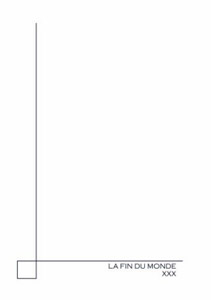 Consisting of the pair of artists that curate the Menstrual Recordings label, who have been heavy on the MB reissues, it is not at all surprising that Dedali and Disruptor’s grey, depressive electronics owe a notable debt to Bianchi’s legacy. However, their music stands entirely on its own, both in its emphasis on audio visual presentation and their approach to sound design. The lineage of this lavish CD/DVD set is clear, but the two manage to carve out their own niche as well.
Consisting of the pair of artists that curate the Menstrual Recordings label, who have been heavy on the MB reissues, it is not at all surprising that Dedali and Disruptor’s grey, depressive electronics owe a notable debt to Bianchi’s legacy. However, their music stands entirely on its own, both in its emphasis on audio visual presentation and their approach to sound design. The lineage of this lavish CD/DVD set is clear, but the two manage to carve out their own niche as well.
The music contained on the CD portion of this package is a different mix than what scores the accompanying short films, so while the two share some similar moments, each disc is it is own distinct entity.The stand alone audio disc, Neurological Possession, is a great example of a modernized take on that bleak electronic sound pioneered by the likes of Bianchi, and also Murder Corporation and Atrax Morgue, but having a more inviting, almost classically musical timbre to it.The first of the three-part title suite is all reverberated drifts and cavernous noises, with a few snippets of mantra like voices appearing throughout, emphasizing the theme of religious fervor that is the predominant theme of the work.
The second and third parts are quite different from one another, with the former consisting mostly of shifting and almost melodic passages of sound, with a DX7 synthetic bell tolling in the mist.As a whole, it is the most spacious and inviting performance here, if still somewhat sad and morose.The third part is much more of a grimy analog synth throb that channels Bianchi more directly, as it does some of Atrax Morgue’s less aggressive material.This especially makes sense, given it was constructed using the late Pierpaolo Zoppo’s (Mauthausen Orchestra) equipment.
The long closer "Internal Bleeding" takes up almost half of the disc, and uses that extended time to stretch out and float into many different directions.Made up partially of demos, sketches, and pieces of material that were recorded for a collaboration with Maurizio Bianchi, it encapsulates the sound of the album perfectly, balancing reverb heavy tones and percussive bits with some of its harsher moments.
The video accompaniment is notably more traditional in its approach, relying on lots of grainy black and white footage of nudity, graveyards, and religious iconography that are reminiscent of avant garde cinema filtered through a more cliché giallo toolkit. Other videos are expanded to images of social unrest, pornography, and medical footage, which is an obvious antecedent of works by SPK and Cabaret Voltaire some 30 years prior.It is nothing new or groundbreaking on its own, but it does fit the early 1980s industrial sensibility of the project very well, albeit not feeling quite as evolved as the music does.
Both a fitting tribute and a splendid, modernized update to the Italian industrial scene from the past, this audio visual collaboration is as much of a tribute as it is a new phase in a familiar sound.Admittedly, the audio portion is a bit more singular than the video is, but both have a distinct familiarity and nostalgia about them that makes even the occasional cliché endearing and enjoyable.Like a film that can recapture the essence of an era without always pushing it into new territories, it is engaging and tinged with just enough nostalgia to feel right.
samples:
 
Read More

